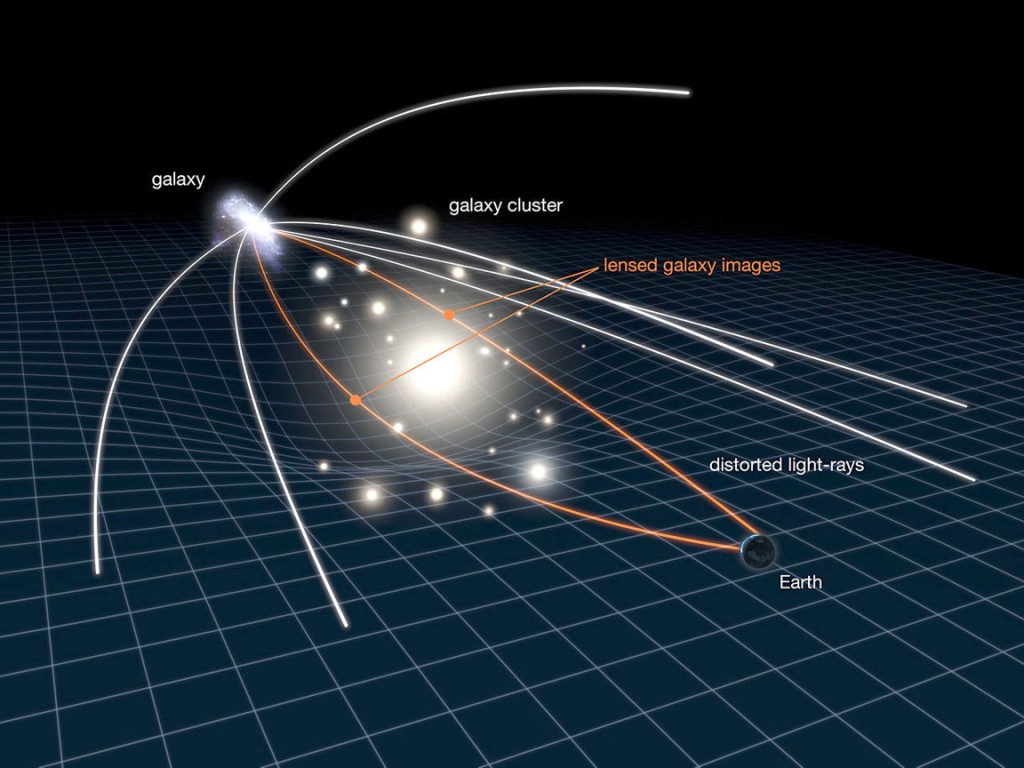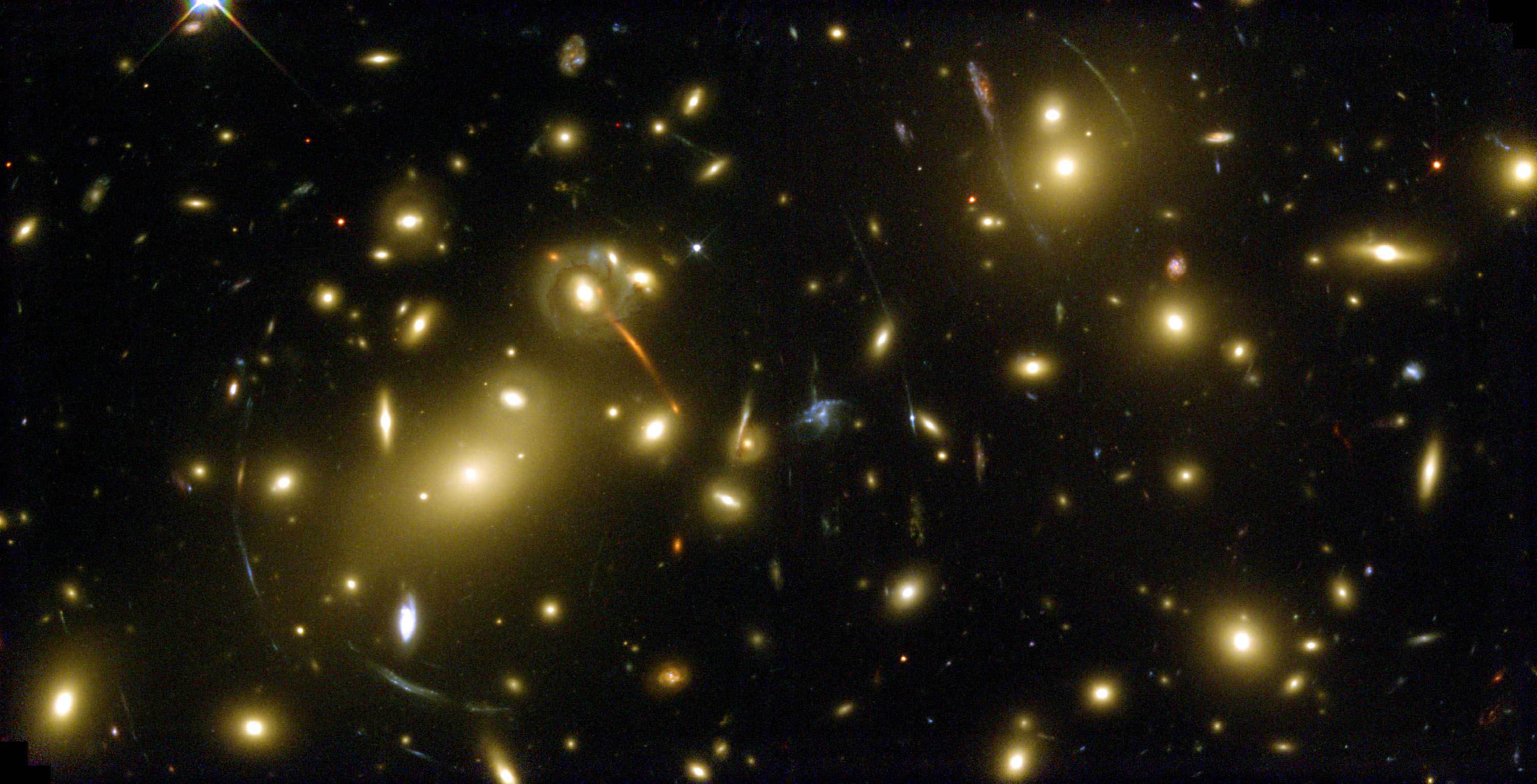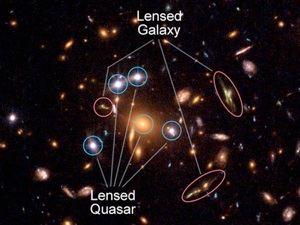Skip to comments.
If the universe is only 14 billion years old, how can it be 92 billion light years wide?
YouTube ^
| June 19, 2019
| Dr. Don Lincoln - Fermilab
Posted on 07/08/2019 12:00:21 PM PDT by ETL
click here to read article
Navigation: use the links below to view more comments.
first previous 1-20, 21-40, 41-60, 61-80 ... 141-160 next last
To: Henchster
Re: "If the universe is only 14 billion years old, how can it be 92 billion light years wide?"
Simple. By the time you get to the other side traveling at the speed of light, it will be 106 billion years old.
Not so "simple" All the while as you were traveling, the universe would be continuing to expand and grow larger.
41
posted on
07/08/2019 12:30:08 PM PDT
by
ETL
(REAL Russia collusion! Newly updated FR Page w/ Table of Contents! Click ETL)
To: dangus
You were making excellent points.
But then maybe the universe is older than they estimate currently.
To: LesbianThespianGymnasticMidget
OK, “origin” of the universe.
43
posted on
07/08/2019 12:33:38 PM PDT
by
dangus
To: ETL
I don’t see a problem. Size and age are two different things. The entire universe may have been created in one day 14 billion years ago.
To: dead
When I say no speed limit, I only mean that we don't know of any restriction (such as speed of light) on the rate of inflation. It didn't move with infinite speed. Firstly, "Inflation", as in Inflation Theory, a theory having to do only with the first near-infinite fraction of a second at the very beginning, is a still highly controversial idea, among many in the field. Secondly, yes, space-time itself, according to theory, does not follow the "nothing can travel faster than light" rules, because it doesn't involve a physical (mass-containing) object traveling through space.
And yes, the still accelerating expansion of space-time complicates the equations further.
That it certainly does.
45
posted on
07/08/2019 12:39:25 PM PDT
by
ETL
(REAL Russia collusion! Newly updated FR Page w/ Table of Contents! Click ETL)
To: LesbianThespianGymnasticMidget
Why sure! It could be anything until Einstein passed his law.
46
posted on
07/08/2019 12:40:20 PM PDT
by
GingisK
To: dead
Yeah, we were there. We observed that, hands down.
47
posted on
07/08/2019 12:41:20 PM PDT
by
GingisK
To: ETL
How can the Rio Grande River be nearly 2000 miles long but only 5 feet deep?.............
48
posted on
07/08/2019 12:41:30 PM PDT
by
Red Badger
(We are headed for a Civil War. It won't be nice like the last one....................)
To: Karma_Sherab
☑
49
posted on
07/08/2019 12:42:18 PM PDT
by
Tolerance Sucks Rocks
(Show me the people who own the land, the guns and the money, and I'll show you the people in charge.)
To: ETL
Lets explain this backwards
The universe has a width. If one assumes the starting point to the edge of the universe were to travel at max speed (speed of light) then the universe can only be 2x speed of light x years old = 28 light years wide.
Measurements indicate that it is 92 light years wide - a significant difference. So either our observations are not correct -or- the speed of light has been different in the past -or- matter CAN exceed the speed of light
50
posted on
07/08/2019 12:43:31 PM PDT
by
taxcontrol
(Stupid should hurt - dad's wisdom)
To: GingisK
No, we didn’t observe that. It’s theoretical.
51
posted on
07/08/2019 12:44:25 PM PDT
by
dead
(Our next president is going to be sooooo boring.)
To: buckalfa; simpson96
Senator Dirkson claimed he never said that now famous line, that it was made up by a reporter [imagine that!] he talked to on a commercial flight, but it sounded so good he never bothered to deny it!................
52
posted on
07/08/2019 12:45:58 PM PDT
by
Red Badger
(We are headed for a Civil War. It won't be nice like the last one....................)
To: ETL
How can the speed of light be constant considering we have entropy?
53
posted on
07/08/2019 12:46:21 PM PDT
by
\/\/ayne
(I regret that I have but one subscription cancellation notice to give to my local newspaper.)
To: taxcontrol
It’s an optical allusion.................(sic)...........
54
posted on
07/08/2019 12:47:09 PM PDT
by
Red Badger
(We are headed for a Civil War. It won't be nice like the last one....................)
To: dangus
Watch the video. Which universe? The one in the 10th dimension? The universe of all possible universes and the infinite ways they could go?
It boggles the mind. Every time you fart a near infinite number of new universes appear. Every time anything happens universes appear. Everything that could possibly happen has happened and will happen. Everything.
It is all theory and it makes the noggin hurt.
55
posted on
07/08/2019 12:49:05 PM PDT
by
LesbianThespianGymnasticMidget
(TRUMP TRAIN !!! Get the hell out of the way if you are not on yet because we don't stop for idiots)
To: ETL
“Speed of light is the highest speed known to humans. Doesn’t mean it’s the absolutely highest speed in existence. “ - Dr.Rudakov, 1960s
56
posted on
07/08/2019 12:50:32 PM PDT
by
leopud
To: ETL
Achieving near perfect transparency over unimaginable distances while still revealing interesting objects at those distances should be physically impossible. The opacity gradient has to be inconceivably precise to be able to see such interesting details on literally the far side of the universe. For it to be merely random would be like hitting the Power Ball Jackpot, and you can’t hand-wave it away with the Anthropic Principle either.
The Hubble Ultra Deep Field is a wonderful ‘smoking gun’, so to speak. The fact that miraculous photo is possible, that the Universe is seems to be carefully crafted so that we as humans can actually see all these amazing, beautiful, and glorious galaxies by the billions, in my opinion strongly implies that someone or something wants us to see His handiwork.
57
posted on
07/08/2019 12:51:23 PM PDT
by
Gideon7
To: taxcontrol
see #37. Matter can relative to a perspective but can’t according to it’s own.
58
posted on
07/08/2019 12:51:44 PM PDT
by
LesbianThespianGymnasticMidget
(TRUMP TRAIN !!! Get the hell out of the way if you are not on yet because we don't stop for idiots)
To: LesbianThespianGymnasticMidget
Sometime, a long time ago, Occam’s razor and the quest to make the universal constants inevitable rather than miraculous collided, and the matter-antimatter reaction obliterated physicists’ reason.
59
posted on
07/08/2019 12:52:13 PM PDT
by
dangus
To: cymbeline
Re: There, astronomers observed an amazing 3,000+ galaxies!”
“Or reflections or projections of other galaxies.If you're referring to duplicate "gravitationally lensed" images of galaxies, not at all sure, but they may have taken most of them into account.
What is Gravitational Lensing?
When astronomers refer to lensing, they are talking about an effect called
gravitational lensing. Normal lenses such as the ones in a magnifying glass or a pair of spectacles work by bending light rays that pass through them in a process known as refraction, in order to focus the light somewhere (such as in your eye).
Gravitational lensing works in an analogous way and is an effect of Einstein's theory of general relativity – simply put, mass bends light. The gravitational field of a massive object will extend far into space, and cause light rays passing close to that object (and thus through its gravitational field) to be bent and refocused somewhere else. The more massive the object, the stronger its gravitational field and hence the greater the bending of light rays - just like using denser materials to make optical lenses results in a greater amount of refraction.

Image: NASA/ESA
Gravitational lensing happens on all scales – the gravitational field of galaxies and clusters of galaxies can lens light, but so can smaller objects such as stars and planets. Even the mass of our own bodies will lens light passing near us a tiny bit, although the effect is too small to ever measure.
So what are the effects of lensing? The kind of lensing that cosmologists are interested in is apparent only on the largest scales – by looking at galaxies and clusters of galaxies. When astronomers take a telescope image of a part of the night sky, we can see many galaxies on that image. However, in between the Earth and those galaxies is a mysterious entity called dark matter. Dark matter is invisible, but it does have mass, making up around 85% of the mass of the Universe. This means that light rays coming towards us from distant galaxies will pass through the gravitational field of dark matter and hence will be bent by the lensing effect.
Dark matter is found wherever 'normal' matter, such as the stuff that makes up galaxies, is found. For example, a large galaxy cluster will contain a very great amount of dark matter, which exists within and around the galaxies that make up that cluster. Light coming from more distant galaxies that passes close to a cluster may be distorted – lensed – by its mass. It is the dark matter in the cluster that does almost all of the lensing as it outweighs regular matter by a factor of six or so. The effects can be very strong and very strange; the images of the distant, lensed galaxies are stretched and pulled into arcs as the light passes close to the foreground cluster. This can be seen in the image below of the famous Abell 2218 cluster. The real galaxies are not this shape – they are usually elliptical or spiral shaped – they just appear this way because of lensing.

Image: NASA/ESA
This strange shape distortion comes from the fact that galaxies are large objects, and the light rays leaving one side of the galaxy (e.g. the left hand side from our point of view) will pass through a different part of space than the light rays leaving the other side (e.g. the right hand side). The light rays will therefore pass through different parts of the dark matter's gravitational field and will be bent in slightly different ways. The net effect of this is a distortion to the shape of the galaxy image, which can in some cases be very severe. Another interesting effect that can occur due to lensing is the formation of multiple images of the same galaxy. This occurs because light rays from a distant galaxy that would otherwise diverge may be focused together by lensing. From the point of view of an observer on the Earth, it looks as if two very similar light rays have travelled along straight lines from different parts of the sky. You can see this in the orange lines in the schematic above - we can see more than one image of the same galaxy in different places. Lensing can also act like a magnifying glass, allowing us to see images of galaxies that would otherwise be too faint to see.
An example of multiple images is shown below in an image from the Hubble Space Telescope. There are 3 images of the same galaxy, and 5 images of a type of galaxy called a quasar. The images are not the same shape or size because each image will have passed through a different region of space on its journey to us, and hence will have been distorted differently. A technique known as spectroscopy is used to determine which images came from the same galaxy.

Image: NASA/ESA, K Sharon (Tel Aviv University), E. Ofek (Caltech)
source:
http://www.cfhtlens.org/public/what-gravitational-lensing
60
posted on
07/08/2019 12:53:32 PM PDT
by
ETL
(REAL Russia collusion! Newly updated FR Page w/ Table of Contents! Click ETL)
Navigation: use the links below to view more comments.
first previous 1-20, 21-40, 41-60, 61-80 ... 141-160 next last
Disclaimer:
Opinions posted on Free Republic are those of the individual
posters and do not necessarily represent the opinion of Free Republic or its
management. All materials posted herein are protected by copyright law and the
exemption for fair use of copyrighted works.
FreeRepublic.com is powered by software copyright 2000-2008 John Robinson


